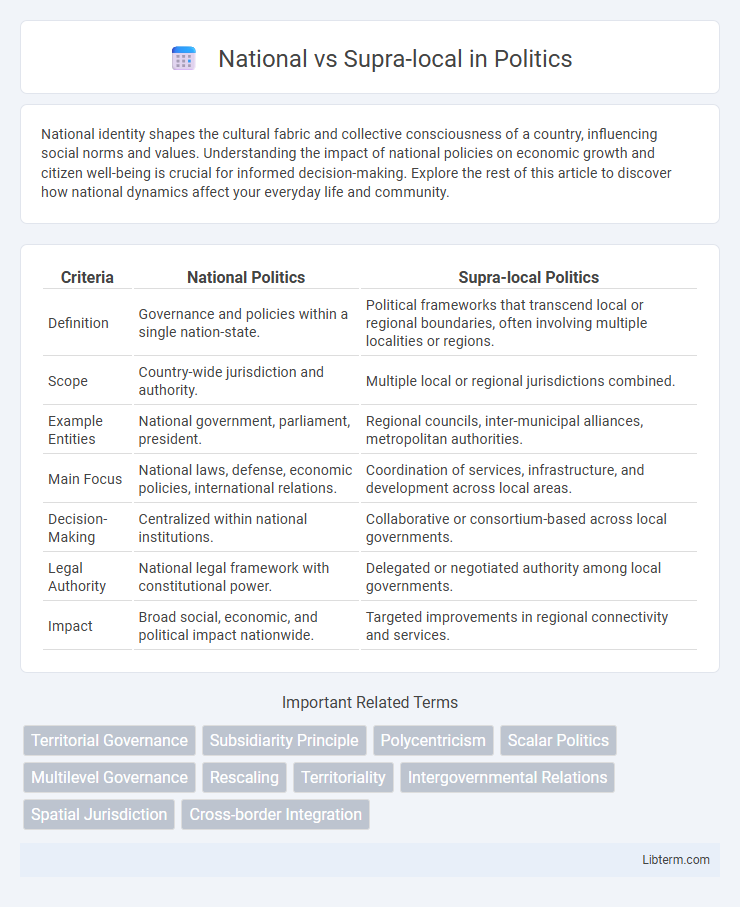National identity shapes the cultural fabric and collective consciousness of a country, influencing social norms and values. Understanding the impact of national policies on economic growth and citizen well-being is crucial for informed decision-making. Explore the rest of this article to discover how national dynamics affect your everyday life and community.
Table of Comparison
| Criteria | National Politics | Supra-local Politics |
|---|---|---|
| Definition | Governance and policies within a single nation-state. | Political frameworks that transcend local or regional boundaries, often involving multiple localities or regions. |
| Scope | Country-wide jurisdiction and authority. | Multiple local or regional jurisdictions combined. |
| Example Entities | National government, parliament, president. | Regional councils, inter-municipal alliances, metropolitan authorities. |
| Main Focus | National laws, defense, economic policies, international relations. | Coordination of services, infrastructure, and development across local areas. |
| Decision-Making | Centralized within national institutions. | Collaborative or consortium-based across local governments. |
| Legal Authority | National legal framework with constitutional power. | Delegated or negotiated authority among local governments. |
| Impact | Broad social, economic, and political impact nationwide. | Targeted improvements in regional connectivity and services. |
Defining National and Supra-local Concepts
National concepts refer to ideas, policies, or frameworks that apply within the boundaries of a single country, encompassing its entire population and territory. Supra-local concepts extend beyond local jurisdictions, involving multiple localities or regions that collaborate or integrate to address shared goals or issues. These supra-local structures often facilitate coordination on economic, environmental, or infrastructural matters that cross individual local boundaries.
Historical Evolution of National vs Supra-local Identities
The historical evolution of national versus supra-local identities reveals shifts from localized, community-based affiliations toward broader national consciousness, driven by the formation of centralized states and the development of shared languages, symbols, and cultural narratives. Industrialization and political revolutions in the 18th and 19th centuries accelerated the emergence of nation-states, fostering supra-local identities that transcended regional distinctions. Modern globalization and transnational institutions continue to reshape these identities, blending national pride with broader supra-local affiliations such as regional or continental identities.
Key Differences Between National and Supra-local Perspectives
National perspectives prioritize policies and strategies that address issues at the country level, integrating diverse regional needs into a unified framework. Supra-local perspectives focus on collaborative efforts between multiple localities or regions, emphasizing shared challenges such as infrastructure, environmental management, and economic development beyond individual jurisdiction borders. Key differences include the scale of governance, with national addressing comprehensive, country-wide objectives, while supra-local centers on inter-municipal cooperation and localized problem-solving across contiguous areas.
The Role of Governance: National vs Supra-local Approaches
National governance structures provide standardized regulations and resource allocation across entire countries, ensuring uniform policy implementation. Supra-local governance involves regional or inter-municipal cooperation that addresses specific local needs more flexibly and promotes tailored solutions. Balancing national consistency with supra-local adaptability is essential for effective public administration and sustainable development outcomes.
Cultural Implications of National and Supra-local Loyalties
National loyalties often reinforce collective identity through shared language, traditions, and historical narratives that unify citizens within a country's borders. Supra-local loyalties transcend national boundaries, fostering cultural exchanges and hybrid identities that challenge exclusive national allegiances. These overlapping loyalties influence social cohesion, impacting policy-making, minority rights, and cultural preservation in multiethnic societies.
Economic Impact: National Versus Supra-local Development
National development strategies drive broad economic growth by leveraging large-scale infrastructure investments and fostering diverse industries, boosting GDP at a country-wide level. Supra-local development targets economic impact within specific metropolitan regions or clusters, enhancing regional competitiveness through specialized innovation hubs and tailored workforce initiatives. The interplay between national policies and supra-local initiatives maximizes economic resilience by balancing wide-reaching reforms with localized adaptability and resource optimization.
National vs Supra-local Policies in Contemporary Society
National policies set broad frameworks addressing economic growth, healthcare, and education across entire countries, ensuring uniform standards and resource allocation. Supra-local policies operate above municipal levels but below national scope, coordinating regional initiatives to address cross-jurisdictional challenges like transportation networks and environmental sustainability. This multi-tiered governance enables tailored solutions while maintaining consistency in policy objectives across regions.
Challenges and Conflicts Between National and Supra-local Interests
Conflicts between national and supra-local interests often arise due to overlapping jurisdictional authority and resource allocation disputes, where national priorities may undermine regional development goals. Challenges include balancing centralized policy enforcement with the diverse socio-economic needs of supra-local entities, which can create tensions in governance and impede cooperative decision-making. Ensuring equitable representation and aligning strategic objectives requires effective coordination mechanisms to mitigate conflicts and promote harmonious integration of policies.
Case Studies Illustrating National and Supra-local Dynamics
Case studies exemplifying national and supra-local dynamics highlight the interplay between centralized government policies and regional cooperation frameworks. Examples from the European Union demonstrate how supra-local governance facilitates cross-border economic development, while national case studies from the United States reveal the complexities of federal-state relations in policy implementation. These analyses underscore the significance of multi-scalar governance approaches in addressing challenges that transcend individual administrative boundaries.
Future Trends: Balancing National and Supra-local Aspirations
Future trends in balancing national and supra-local aspirations emphasize integrated governance models that foster collaboration between central governments and regional entities. Advances in digital infrastructure and data-sharing platforms enable more cohesive policy-making, addressing diverse local needs while maintaining national coherence. Embracing adaptive frameworks supports sustainable economic growth and social equity across multiple jurisdictional levels.
National Infographic

 libterm.com
libterm.com